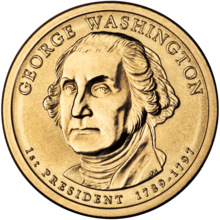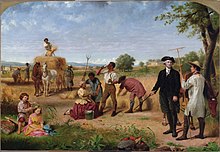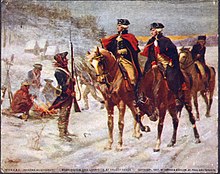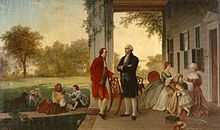
George Washington has been estimated to be one of the wealthiest presidents of the United States. Measures of wealth vary according to calculative measures used. But comparing Washington's net worth of $780,000.00 to the worth of the average modern American would equate to $594.2 million in current value (in 2020). [1] Despite this vast wealth, it was largely made up of valuable assets as opposed to cash reserves, so Washington can be described as asset rich but cash poor. [2]
Assets and liabilities
Assets
Washington accumulated his wealth in several different ways; through employment as a surveyor, Continental Army officer and President; investments in bonds and corporate equities; income from his Mount Vernon plantation and assets inherited from his family and through his wealthy wife. [3] George Washington accordingly had a broad portfolio of assets and investments which contributed to his significant net worth.
As President, Washington drew a significant salary, equal to 2% of the total government budget. [4] Washington was a significant landowner, his 1800 Will recording 52,194 acres of land to be sold or distributed. [5] His Mount Vernon plantation was staffed with 316 slaves, a third of whom Washington owned personally. They farmed tobacco, wheat, corn, flax, and hemp. [6] Moreover, he owned and operated the largest whiskey distillery in America at the time, producing almost 11,000 gallons upon his death. [7] Washington also accumulated a large haul of luxury homewares and clothing, together with lavish foodstuffs he used to entertain guests. [6]

Liabilities
Despite George Washington's significant wealth, he also accrued considerable liabilities across his life and career. Significant taxation imposed by the British greatly affected Washington, consuming 75% of his income by his own estimates. Instead of drawing a salary as leader of the Continental Army, Washington elected to be reimbursed for wartime expenditures. [2] Due to military service his agricultural business became a product of neglect. His extravagances also meant he regularly went into debt to fund his lifestyle, while anticipating income from the sale of the annual harvest. As with many landowners, George Washington was dependent on slave labour to operate his agricultural business. As his slaves grew older, their productivity inevitably declined, and Washington refused to re-sell them on principle due to the potential for families to be dispersed. [3] In the poor economic conditions after the Revolutionary War, Washington was unable to lease or sell his landholdings, making him asset rich but cash poor. [2] Washington's financial constraints continued into his leadership of the Continental Army. The Army was constantly short on money, impugning its ability to expand and rearm and thus leading to failures on the battlefield. Washington was forced to seek funding from France and other backers to keep it afloat. [8] Following his war leadership, he did not receive any pension in recompense for his service. [2]
Wartime expense management


Whilst acting as Commander in Chief of the Continental Army, Washington declined an income of $48 000 in favour of receiving a personal expense account in which he could be reimbursed. During the duration of his involvement in the Revolutionary War (June 19, 1775 – December 23, 1783), Washington managed to amass an expense account totalling $449, 261.51. [9] Despite Washington's expenditures and monetary requests, by October 1780, he had to discharge soldiers in New Jersey, to mitigate the possibility of revolt due to the lack of supplies and the poor health of soldiers. [10] Although warnings were issued to troops, concerns such as desertion and theft continued to arise. [11] This followed prior efforts to acquire more funding and resources, whereby Washington would appeal to congress for further financing on a regular basis. [10] Notably, ‘The Grand Forage’ of February 1778, highlights the extent to which access to supplies had become desperate, whereby logistical issues and sourcing resulted in soldiers needing to forage for supplies. [12] The excursion required 1500–2000 men from multiple segments of the army, a significant portion of manpower which would take a period of 6 weeks to complete. [12] In 1779, the public was subsequently paid by Washington's Army for goods taken, albeit many were not sufficiently compensated and payment was not voluntarily made from Washington's Army. [13]
When Congress had the capacity to respond to Washington's requests for supplies, contractual arrangements were put into operation with some difficulty, but the remaining army was able to be sustained as a result. Soldiers went from having minimal supplies to being better provided for with enough food and general supplies by 1783, but unpaid wages were still a concern, with troops needing to be released from duty. [14] Washington faced a number of financial concerns when managing war expenses, including not only the maintenance of his own troops, but also the feeding of prisoners of war and funding espionage activities. Washington also faced significant pressure in resolving tensions between officers, over supplies and pay for their men. [15] The surviving expense journals illuminate the financial challenges faced by Washington in these difficult circumstances. His bookkeeping demonstrated a great depth of detail for minimal expenses, with minor detail provided for significant expenditures that typically would demand an in-depth breakdown of information. This even extended to vaguely covering expenses for other parties and the terms ‘miscellaneous’ and ‘ditto’ often being relied upon to describe expenditures. [9]
These activities placed a major strain on the economy with the accrual of further debt. Robert Morris worked alongside his assistant Gouverneur Morris and Alexander Hamilton in an attempt to supplement America's economic distress and resolve its debt issues. He implemented an economic program in place to resolve the issues surrounding the nation's debt. However, despite this, Morris used his own wealth to act as a personal creditor in the issuing of notes (named ‘Morris notes’) to pay soldiers. He then resigned from his position to maintain his ability to be a creditor. [16] The condition faced by America following the economic damage incurred by the expenses of the Revolutionary War that Alexander Hamilton, acting as an aide to Washington at this time had strong concerns surrounding the future of broader America was such that he was planning possibly moving to Geneva if New York was no longer a stable place to consider moving to if the situation did not improve. [17] No longer acting as a Commander in Chief for the Revolutionary War and becoming elected as president in 1789, Washington later faced a financially devastated federal government and economy. [18]
Economic interactions

George Washington used his time in and out of public office to interact with the U.S. economy in a way that would benefit both his personal finances and the American people. Washington's interactions with the economy in his public and private lives were characterised by a sense of entrepreneurship, pursuing personal and communal wealth for America.
Personal life
Recognising the economic opportunities present in land acquisition, using his skills as a land surveyor, Washington made much of his wealth from property speculation. His estate was valued at $780,000 in 1799, approximately $429 million in today's money. Relative to the American economy of the time, his estate of $780,000.00 represented 0.19% of the gross domestic product. [6] Taking advantage of an economy in its infancy with associated cheap land prices, Washington purchased 1800-acres of land in 1760 for $1653, the same land selling in 2021 for $50 million. [19] Washington was a proprietor and businessman in his personal life. His interactions with the US economy can be classified as entrepreneurial and pro-business in nature.
Public life
When he came into power in 1789, Washington was met by an economy in disarray. He was tasked with repairing a financial situation that saw ballooning post-revolution debts and inflation. [20] Washington appointed Alexander Hamilton as his Secretary of Treasury that same year. [21] It is through this partnership with Hamilton that Washington was able to interact with and impact the American economy, whereby they developed a three-stage plan to help the US economy. Firstly, the Federal government would take on state debt, paying it back in full; secondly, they planned to pay back bonds issued during the war at face value; and finally, legislation was passed to facilitate the creation of a national bank. [22] His government was keen on promoting domestic manufacturing, assisted by the Report on the Subject of Manufacturers in 1791. [23] His policies of careful debt repayments via taxation and promotion of manufacturing aimed towards the creation of national wealth were relatively novel in the 18th century, contrasting against the British Mercantilist system. [24] Washington voiced his opposition to the British commandeering of profits from the Virginian tobacco trade, asking, "Can it be otherwise than a little mortifying to find that we, who … contribute so largely to the dispatch of your ships in this country should meet with such unprofitable returns?". [25] His economic policies were consistent with his personal interests in the economy. [26] He sought to achieve stability, while also encouraging business and entrepreneurship through his promotion of manufacturing activities. As President, Washington's policies would help to transform and invigorate the American economy. Consequently, for the last decade of the 18th century, GDP per capita would grow by 9.78% per year, matching the per capita output of the British empire 20 years later. [27] This significant economic growth accordingly benefited Washington by improving the value of his holdings.
References
- ^ Sauter, Michael; Suneson, Grant; Stebbins, Samuel (November 5, 2020). "From Washington to Trump: This is the Net Worth of Every American President". USA Today. Retrieved October 27, 2022.
- ^ a b c d Randall, Willard (February 21, 2022). "How Wealthy Were the Founding Fathers?". Time. Retrieved October 27, 2022.
- ^ a b "We're Wealthy Already and Bound to Get Richer". Museum of American Finance. n.d. Retrieved October 27, 2022.
- ^ Elkins, Kathleen (July 4, 2016). "Here's what it was like to be George Washington, the richest president in US history". The Life of George Washington, the Richest President in US History. Business Insider. Retrieved October 27, 2022.
- ^ Redmond, Edward (n.d.). "Washington as Land Speculator". George Washington: Surveyor and Mapmaker. Library of Congress. Retrieved November 4, 2022.
- ^ a b c Gardner, Andrew (2013). "How Did Washington Make His Millions?". Colonial Williamsburg. Winter. Retrieved October 27, 2022.
- ^ Geiling, Natasha (May 12, 2014). "Long Before Jack Daniels, George Washington Was a Whiskey Tycoon". Smithsonian Magazine. Retrieved November 4, 2022.
- ^ McCraw, Thomas K (2012). The Founders and Finance: How Hamilton, Gallatin and Other Immigrants Forged a New Economy. Cambridge, Massachusetts: Harvard University Press. pp. 27, 48, 50. ISBN 9780674067660.
- ^ a b "George Washington's Expense Account: 'The Father of His Country' Won the Revolutionary War on a Classic Expense Account". Management Accounting (Pre 1986); Montvale. 52 (6). Montvale: Institute of Management Accountants: 60, 64. December 1970. ISSN 0025-1690.
- ^ a b Ver Steeg, Clarence (2017). Robert Morris: Revolutionary Financier, with an Analysis of His Earlier Career. Philadelphia: University of Pennsylvania Press. pp. 47–48, 118, 163, 169, 192. ISBN 9781512819120.
- ^ Southall Freeman, Douglas (1948). George Washington: A Biography. New York: Charles Scribner's Sons. p. 206. ISBN 0678028346.
- ^ a b Herrera, Ricardo A (2022). Feeding Washington's army: surviving the Valley Forge winter of 1778. Chapel Hill: University of North Carolina Press. pp. 2–4. ISBN 9781469667331. Retrieved October 26, 2022.
- ^ McCraw, Thomas K (2012). The Founders and Finance: How Hamilton, Gallatin and Other Immigrants Forged a New Economy. Cambridge, Massachusetts: Harvard University Press. p. 48. doi: 10.4159/harvard.9780674067660. ISBN 9780674067660. S2CID 253147108. Retrieved October 26, 2022.
- ^ Ver Steeg, Clarence (2017). Robert Morris: Revolutionary Financier, with an Analysis of His Earlier Career. Philadelphia: University of Pennsylvania Press. p. 163. ISBN 9781512819120. Retrieved October 26, 2022.
- ^ Cox, Caroline (December 2012). Lengel, Edward G (ed.). "Papers of George Washington: Revolutionary Series". Journal of American History. 99 (3). Charlottesville: University of Virginia Press: 892. doi: 10.1093/jahist/jas349.
- ^ Ver Steeg, Clarence (2017). Robert Morris: Revolutionary Financier, with an Analysis of His Earlier Career. Philadelphia: University of Pennsylvania Press. pp. 118, 169, 192. ISBN 9781512819120. Retrieved October 26, 2022.
- ^ McCraw, Thomas K (2012). The Founders and Finance: How Hamilton, Gallatin and Other Immigrants Forged a New Economy. Cambridge, Massachusetts: Harvard University Press. p. 50. doi: 10.4159/harvard.9780674067660. ISBN 9780674067660. S2CID 253147108. Retrieved October 26, 2022.
- ^ "George Washington". Museum of American Finance. n.d. Retrieved October 26, 2022.
- ^ Cherner, Jessica (November 4, 2021). "Part of George Washington's Original Mount Vernon Farm Sells for a Record Sum". Architectural Digest. Retrieved October 28, 2022.
- ^ "Hamilton's Financial Plan". U.S. History Online Textbook. ushistory.org. n.d. Retrieved October 28, 2022.
- ^ "Alexander Hamilton and George Washington". National Park Service. United States Government. May 14, 2022. Retrieved October 28, 2022.
- ^ Chervinsky, Lindsay M (n.d.). "George Washington: Domestic Affairs". Miller Center. University of Virginia. Retrieved October 28, 2022.
- ^ "Alexander Hamilton's Final Version of the Report on the Subject of Manufactures, [5 December 1791]". Founders Online. National Archives. Retrieved October 28, 2022.
- ^ "George Washington: America's First Entrepreneur". Knowledge at Wharton. University of Pennsylvania. April 19, 2016. Retrieved October 28, 2022.
- ^ Unger, Harlow Giles (2006). The Unexpected George Washington: His Private Life. USA: Wiley. p. 59. ISBN 0471744964.
- ^ Lawrence, Henry W. (May 1, 1932). "Washington, Capitalism, and Nationalism". JSTOR. Retrieved January 28, 2024.
- ^ Ansary, Cyrus A (February 17, 2019). "What Do Steve Jobs, Jeff Bezos, and Oprah Winfrey Have in Common? A Little Help from George Washington". History Is Now Magazine. Retrieved October 28, 2022.